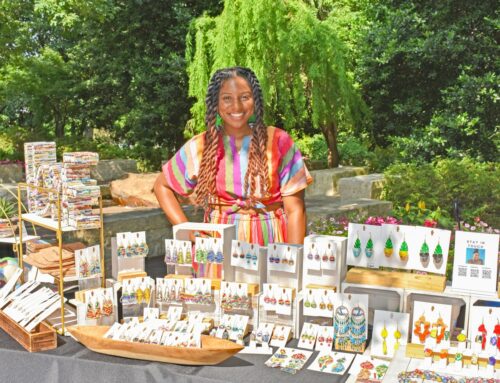Neighborhood resident Ted Knight has a way with wood – so much so that his sculptured wood vessels are on display in galleries and homes nationwide and throughout the world.
A former architect, Knight left his chosen profession about five years ago to sculpt full-time. Doing so, he says, was a great career move.
“I now exist solely as an artist, and I’m making a great living,” he says. “Nothing could be better than to be a born artist and be able to do what you love.”
Calling himself a wood-turner rather than a sculptor, he creates his intricate vessels on a lathe, turning and cutting until the piece is as close to perfection as possible.
“The work is technically very difficult, and I’ve pushed the limits for so many years that I really have very little competition in the field.”
Knight has been “pushing the limits” for 35 years, in fact. He began working in wood during junior high school in the Carrollton-Farmers Branch area. When he was first introduced to the lathe, he remembers thinking, “I like this a lot – I want to do this for a long time.”
Later, he became an architect because he loved to design.
“I loved the discipline, structure and design involved in building things. I particularly enjoyed residential architecture. That was my specialty.”
During the 20 years and more that Knight had his own architectural design firm, he continued experimenting with wood and earning a local and national reputation as an artist. He typically had two one-man shows a year while working full-time as an architect.
Now Knight does only juried art shows, the most prestigious of showings. At a juried show, a team of art professionals determines whether or not an artist will have his work displayed by weighing the artist’s reputation and viewing examples of his work.
Today, some of Knight’s pieces fetch $10,000 or more. If that seems incredible, consider the process that goes into creating a piece, which takes a minimum of two years.
Knight uses mostly wood indigenous to Texas, such as pecan, hackberry, black walnut, sycamore, ash and elm. In addition, he makes yearly pilgrimages to New Mexico for pondersosa pine and to northern California for myrtle wood or fiddlehead maple.
When he finds a piece of wood he wants to work with, he sets it aside to “spalt” for a year. As he explains, “Wood becomes ‘spalted’ when it’s attacked by fungus. Eventually it will kill a tree, but over a short period it gives the wood an interesting appearance. For instance, hackberry takes on a lacy black look.”
Next, Knight performs a “rough” turning with the lathe, hollowing out the insides but leaving a thick wall.
The natural drying process follows, and that takes another year. During that time, the piece shrinks and warps slightly. Afterward, the wood is kiln-dried for three weeks.
Then it’s back on the lathe. The outside profile is cut – and this is a critical point, because wit h one slip the piece will break and be ruined.
If all goes well, it’s “sand, sand, until you’ve sanded forever, and then you sand some more, “ Knight says with a laugh.
The finishing touch is a type of lacquer similar to the final coat given a concert violin or any other fine musical instrument. The exact recipe for the finish is a secret Knight won’t divulge.
And then, the completed artwork – a product of more than two years’ work and talent. Is it worth the price? Collectors from around the world have told Knight that it is, indeed.
Knight’s wooden vessels are shown locally at the Anasazi Gallery on Inwood Road in Dallas.





